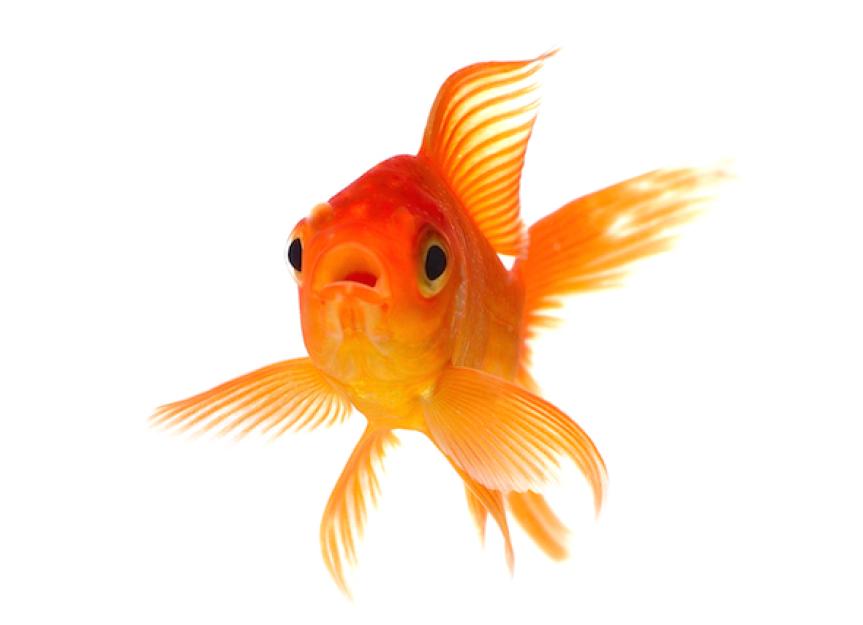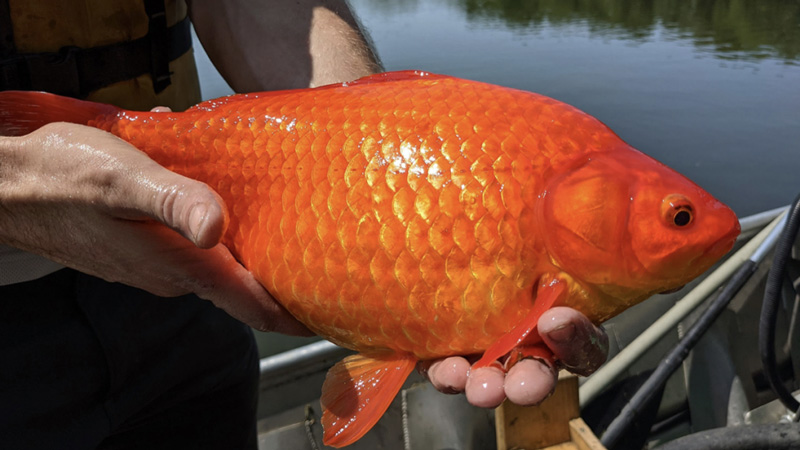Goldfish are called goldfish due to their golden-orange color. This distinct hue sets them apart from other fish species.
Goldfish, scientifically known as Carassius auratus, are one of the most popular pets worldwide. Originating from East Asia, they were selectively bred for their striking color and unique features. Their bright, metallic hues range from orange to red, sometimes even white and black.
Goldfish thrive in a variety of environments and are known for their hardy nature. These fish have captivated humans for centuries with their beauty and ease of care. Whether in a small home aquarium or a large outdoor pond, goldfish bring a touch of elegance and serenity to any setting. Their vibrant colors and gentle movements make them a favorite among aquarists.
The Origin Of Goldfish
The story of why goldfish are called goldfish is fascinating. It begins over a thousand years ago. This journey takes us to ancient China, where these beautiful creatures were first cultivated.
Ancient Roots In China
Goldfish have their roots in ancient China. The Chinese started breeding them over a thousand years ago. They valued these fish for their beauty and grace. Goldfish were initially a type of carp. Carp were common in Chinese ponds and lakes.
Chinese breeders noticed some carp had unique colors. These colors included orange, red, and yellow. They began to breed these colorful carp selectively. Over time, these fish became known for their bright, golden hues.
From Carp To Goldfish: A Colorful Transformation
The transformation from carp to goldfish was magical. Initially, carp were grey or silver. Selective breeding brought out their vibrant colors. The process took many years and much patience. Breeders focused on fish with the brightest colors. They bred these fish to enhance their golden hues.
Here is a simple table showing the transformation:
| Type | Color |
|---|---|
| Carp | Grey/Silver |
| Early Goldfish | Orange/Red |
| Modern Goldfish | Golden |
This careful breeding resulted in the goldfish we know today. These fish are famous for their bright, golden color. This is why they are called goldfish. The name reflects their beautiful, golden appearance.
The Etymology Behind The Name
The name “goldfish” seems straightforward. But why are they called goldfish? This section dives into the history and meaning behind this popular pet’s name.
The ‘gold’ In Goldfish
The word “gold” in goldfish refers to their color. These fish have a brilliant, golden hue. This color made them stand out among other fish. Not all goldfish are gold, though. They can also be orange, white, black, and red.
The gold color comes from selective breeding. Early breeders in China aimed to create fish with a bright and shiny appearance. Over time, these golden fish became very popular. Their unique color and shine earned them the name “goldfish.”
Cultural Significance Of Color
Gold has special meaning in many cultures. In China, gold represents wealth and good fortune. Goldfish were kept by the rich and powerful as a status symbol. They were also given as gifts to bring luck and happiness.
Goldfish are also associated with beauty and grace. Their elegant swimming and bright colors make them a joy to watch. In art and literature, goldfish often symbolize prosperity and harmony.
Goldfish are more than just pets. They carry deep cultural meanings and history. Their name reflects their beauty and significance.
Goldfish Through The Ages
The goldfish is more than just a pet. This small creature has a rich history. Let’s explore how goldfish have influenced art, literature, and culture.
Goldfish In Art And Literature
Goldfish have inspired artists and writers for centuries. In ancient China, artists often depicted goldfish in their paintings. These artworks highlighted the beauty and elegance of the fish.
In literature, goldfish symbolize many things. In some stories, they represent luck and prosperity. In others, they are a sign of peace and calm. Authors use goldfish to convey these themes in their stories.
| Era | Art Example |
|---|---|
| Ancient China | Paintings and Porcelain Designs |
| Renaissance | European Paintings |
| Modern Times | Children’s Books and Illustrations |
Symbolism Across Different Cultures
Goldfish hold various meanings across cultures. In China, they are symbols of wealth and good fortune. Families often keep goldfish in their homes for luck.
In Japan, goldfish are linked with peace and harmony. They are common in gardens and ponds, adding to the tranquil setting.
- China: Wealth and Good Fortune
- Japan: Peace and Harmony
- Western Cultures: Beauty and Grace
In Western cultures, goldfish are seen as beautiful and graceful. They often appear in decorative ponds and aquariums. People admire their bright colors and elegant movements.
These diverse symbols show the goldfish’s broad appeal. They connect with people from all walks of life.

Credit: www.petmd.com
Selective Breeding And Genetic Mutations
Goldfish are not naturally golden. Their color comes from selective breeding and genetic mutations. Breeders have worked for many years to achieve this vibrant look.
The Science Of Coloration
Goldfish have cells called chromatophores. These cells contain pigments that give them their color. There are different types of chromatophores:
- Melanophores (black)
- Xanthophores (yellow)
- Erythrophores (red)
- Iridophores (reflective/iridescent)
Through selective breeding, breeders have increased the number of xanthophores and erythrophores. This results in the gold and red hues seen in goldfish today.
Breeding Practices For Aesthetic Appeal
Breeders choose goldfish with the most desirable colors for mating. They do this to enhance the goldfish’s appearance over generations. Here are some common practices:
- Pair Selection: Choosing pairs with vibrant colors.
- Controlled Environment: Ensuring the right habitat for optimal color development.
- Genetic Monitoring: Tracking genetic traits to avoid unwanted mutations.
Breeders also look for unique patterns and tail shapes. This adds to the aesthetic appeal of goldfish.
A table showing common goldfish varieties and their characteristics:
| Goldfish Variety | Color | Special Traits |
|---|---|---|
| Comet | Red, orange, white | Long, flowing tail |
| Oranda | Red, orange, white | Head growth called “wen” |
| Ryukin | Red, orange, white | Humped back |
Selective breeding and genetic mutations have created the goldfish we see today. These practices continue to shape the future of goldfish coloration and form.
Myths And Misconceptions
Goldfish are fascinating creatures with a rich history. Despite their popularity, many myths and misconceptions exist about them. This section aims to clear up some of these misunderstandings.
Common Goldfish Myths Debunked
Many believe goldfish have a three-second memory. This is not true. Goldfish can remember things for months. Another myth is that goldfish grow to fit their tank size. This is also false. Goldfish can grow very large if given enough space.
- Myth: Goldfish only live for a few years.
- Fact: With proper care, goldfish can live over 10 years.
- Myth: Goldfish can be kept in bowls.
- Fact: Goldfish need large tanks to thrive.
Factual Vs. Fictional Attributes
Goldfish have many fascinating traits. Some are factual, while others are fictional. Let’s explore them.
| Attribute | Factual | Fictional |
|---|---|---|
| Memory | Goldfish can remember for months. | Goldfish have a three-second memory. |
| Growth | Goldfish can grow very large. | Goldfish grow to fit their tank. |
| Lifespan | Goldfish can live over 10 years. | Goldfish live only a few years. |
Understanding these facts can help you take better care of your goldfish. They deserve the best environment possible.

Credit: www.nationalgeographic.com
The Global Journey Of Goldfish
The global journey of goldfish is a fascinating tale. This journey started in East Asia and spread worldwide. Their beauty and adaptability made them beloved pets across cultures.
Spread From East To West
Goldfish were first domesticated in China over a thousand years ago. Chinese breeders selectively bred them for their colors and shapes. They soon became a symbol of wealth and luck.
By the 17th century, goldfish had made their way to Japan. Japanese breeders further refined their appearance. Goldfish then traveled to Europe through trade routes. They were first introduced in Portugal and quickly spread across the continent.
In the 19th century, goldfish reached the United States. They became a popular pet due to their vibrant colors and ease of care. This marked the beginning of their global popularity.
Goldfish As Global Pets
Today, goldfish are one of the most common pets worldwide. They thrive in small tanks and garden ponds. Their hardy nature makes them suitable for novice pet owners.
Goldfish come in various breeds, each with unique features. Some popular breeds include:
- Comet Goldfish: Known for their long, flowing tails.
- Fantail Goldfish: Recognized by their double tail fins.
- Oranda Goldfish: Famous for their distinctive head growth, called a wen.
Goldfish are also culturally significant in many regions. In China, they symbolize prosperity and good luck. In Japan, they are a staple in summer festivals and often appear in traditional art.
Despite their widespread popularity, goldfish care requires attention. They need clean water, a balanced diet, and ample space to swim. Proper care ensures they live long, healthy lives.
| Breed | Features |
|---|---|
| Comet Goldfish | Long, flowing tails |
| Fantail Goldfish | Double tail fins |
| Oranda Goldfish | Distinctive head growth (wen) |
Goldfish continue to captivate people worldwide. Their journey from East to West is a testament to their enduring appeal.
Caring For Goldfish
Caring for goldfish is essential for their well-being. These beautiful pets need proper attention and a suitable environment. Below are some crucial aspects to consider for their care.
Essential Habitat Requirements
Goldfish need a clean and spacious tank. A minimum of 20 gallons per fish is ideal. Use a quality water filter to maintain cleanliness. Goldfish thrive in water temperatures between 65-75°F.
Ensure the water pH stays between 6.5 and 8.0. You can add aquatic plants to the tank. These plants provide oxygen and shelter for the fish. Avoid sharp decorations that can harm them.
Health And Longevity
Goldfish can live up to 10-15 years. Healthy goldfish have bright colors and active behavior. Regularly check for signs of illness. Common signs include white spots and clamped fins.
Feed your goldfish a balanced diet. Offer flakes, pellets, and occasional treats like peas. Overfeeding can cause health issues. Remove uneaten food to keep the tank clean. Regular water changes also help maintain their health.
Conservation And Ethical Considerations
Goldfish are not just pets. They impact the environment and require ethical care. Understanding these factors helps in responsible goldfish keeping.
Environmental Impact Of Goldfish
Goldfish, when released into the wild, can disrupt local ecosystems. They compete with native fish for food and resources. This can lead to the decline of local species.
Goldfish also contribute to water pollution. Their waste increases nutrient levels, causing harmful algal blooms. This affects water quality and other aquatic life.
Preventing goldfish from entering natural water bodies is essential. Always dispose of unwanted goldfish responsibly.
Responsible Goldfish Keeping
Responsible goldfish keeping starts with proper tank size. A small bowl is not suitable. A large tank with a filter is ideal.
Goldfish need clean water. Regular water changes and monitoring of water quality are crucial. Use a water conditioner to remove harmful chemicals.
Feeding goldfish the right diet is also important. Overfeeding can cause health issues. Provide a balanced diet of flakes, pellets, and occasional treats.
Goldfish are social animals. They thrive in groups, so consider keeping more than one. Ensure the tank is big enough for all the fish to swim freely.
Regular health check-ups are necessary. Look for signs of illness like lethargy, changes in appetite, or unusual spots. Early detection helps in effective treatment.

Credit: www.dnr.state.mn.us
Conclusion
Goldfish got their name due to their vibrant, golden color. These charming fish have fascinated people for centuries. Their beauty and easy care make them popular pets. Understanding their origins adds to their allure. Next time you see a goldfish, you’ll appreciate the story behind its name.
